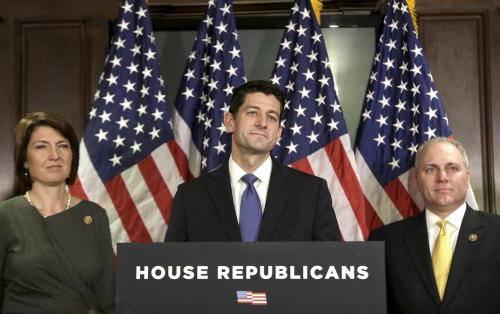This post originally appeared on Real Clear Politics on February 22, 2017.
Many Americans are fed up with the pace of improvement for themselves and their families. In fact, data from the Pew Research Center showed that more than half of Trump supporters at the time of the election preferred new approaches that might solve the country’s major problems quickly, even at the risk of making things worse. These Americans believe that faster progress on issues such as education, poverty, and economic mobility won’t happen by simply spending more on the same old strategies.
We agree, despite our political differences. While our nation has made important progress in recent years in terms of job creation, health insurance coverage, and high school graduation rates, too many key indicators over the last 40 years have stagnated. Reading and math achievement of high school students has remained virtually unchanged over the past 40 years, the official poverty rate that focuses on earnings has been relatively flat since the late 1970s, obesity rates among poor children have remained elevated, and the average yearly income of the bottom 40 percent of American households has been stuck in place since 1980. The United States clearly needs better paths to mobility into the middle class.
So how can President Trump accelerate progress? An important piece of the answer is buried under the noise and rancor of partisan debates in Washington. It is a growing movement within the federal government to get better results at lower cost for American citizens through evidence-based policymaking. Who could be against that? It is why it has been a bipartisan effort, started under President George W. Bush and expanded by President Obama. Government agencies are using rigorous program evaluation, data, and innovation to test new ideas and see what works, while improving the results and cost-effectiveness of social spending. That includes housing assistance, job training, education, welfare programs, and more.
The movement dovetails with similar efforts among both red and blue states, including in Colorado, New Mexico, Minnesota, Mississippi and Rhode Island. At the federal level, its bipartisan support was recently underscored by the launch of the Commission on Evidence-Based Policymaking, co-sponsored by Republican Speaker of the House Paul Ryan and Democratic Senator Patty Murray. The Commission is working to increase the availability of government data that can show which government programs need to be improved or eliminated and which are succeeding.
Today, we have a growing number of examples showing that building evidence about what works is a twofer: it can improve lives and save money.
Today, we have a growing number of examples showing that building evidence about what works is a twofer: it can improve lives and save money. For instance, when the Department of Housing and Urban Development and Department of Veterans Affairs drew on high-quality research to shift their strategy for reducing veteran homelessness, thousands of vets were able to leave the streets and lead more stable and productive lives.
Another example is the Department of Health and Human Services’ Home Visiting Program. It funds evidence-based approaches to home visiting, such as the Nurse Family Partnership, to help first-time, low-income mothers ensure their children are healthy and ready to learn. As a result, more disadvantaged mothers are receiving quality help at a critical period in their children’s lives. HHS also provides smaller grants to test out new approaches and create a pipeline of more effective home visiting programs.
A third example could be in development: The Supplemental Nutrition Assistance Program (SNAP), formerly known as food stamps, is likely to support state efforts to restrict the use of SNAP benefits to purchase unhealthy products such as sugar-sweetened beverages which have been shown to be a leading contributor to elevated rates of obesity in children. Such state experiments should be accompanied with thorough evaluations so we can learn whether the restrictions lead to changed behavior and better health outcomes. A commitment to evidence-based policy requires a willingness to challenge the status quo with bold innovations.
An important influence of the evidence movement – and one that will resonate with the new Trump administration – is leading companies in the private sector that use a range of practices to drive results and create a culture of continuous improvement. These companies use data analytics to track performance and diagnose problems, encourages rapid experimentation called A/B testing to try out new approaches and make refinements based on the results, and makes strategic investments that maximize the return on investment and reduce risk.
The gulf between data-driven, evidence-based management among leading private sector companies and standard practices in government is slowly starting to narrow. In the last decade, federal departments have increased their use of data for management and research, something that sounds basic, but has not been standard practice for government. More federal departments are also using A/B testing to find ways to improve customer service. And more have implemented innovative grant programs, as in home visiting, that provide larger grants for approaches backed by stronger evidence of effectiveness – an approach championed by the Obama administration and endorsed by Speaker of the House Paul Ryan and House Republicans in their 2016 policy blueprint, “A Better Way.”
Harnessing research evidence to focus on what works, and stop doing what doesn’t, seems like a no-brainer.
Harnessing research evidence to focus on what works, and stop doing what doesn’t, seems like a no-brainer. “Whose evidence, though?” you might ask. “Can’t studies be twisted to support any political position?” A key to bipartisan progress on evidence-based policy has been setting the bar high in terms of what “evidence-based” really means. Strong evidence, based on high-quality research methods, provides reliable information to policymakers that is tough to spin.
Today, the evidence agenda is at a crossroads: Will the Trump administration build on bipartisan progress and continue to strengthen the ability of federal agencies to learn and do what works? We hope so. The new Administration has an enormous opportunity to improve the results and cost-effectiveness of existing federal programs, while also making informed choices about what to stop doing. A bold effort of reform, if done in a bipartisan way that emphasizes program improvement, would benefit millions of Americans and increase the return on investment from current spending. Just as important, it would help increase Americans’ confidence that their federal government is able to effectively and efficiently tackle the challenges we face as a nation.
The Brookings Institution is committed to quality, independence, and impact.
We are supported by a diverse array of funders. In line with our values and policies, each Brookings publication represents the sole views of its author(s).











Commentary
Op-edTrump should support bipartisan “evidence based” revolution
February 22, 2017